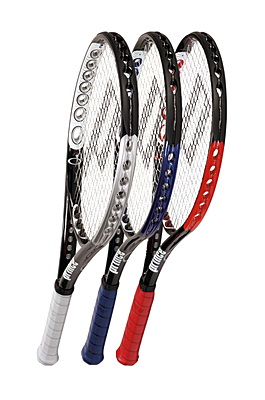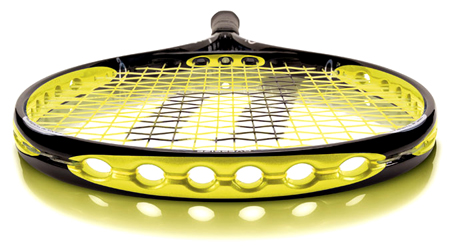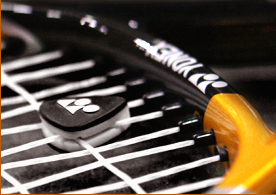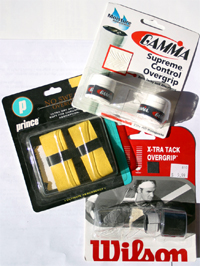|
Tennis Racquets
Author:
Stan Reents, PharmD
Original Posting:
02/21/2012 09:46 AM
Last Revision: 12/10/2018 06:00 AM
Whether you're buying your first tennis racquet or trying to advance your current game, there are a few key things to keep in mind as you shop for a new racquet. It is vital that the tennis equipment you use fits your skill level. You should buy a racquet that suits your size, swing and ability.
GENERAL GUIDELINES
The 5 major characteristics to consider when evaluating a tennis racquet are:
- power
- control
- maneuverability
- stability
- comfort
No frame will be perfect for you in all 5 categories. And how a racquet is strung can drastically affect how it feels. Often, a racquet that ranks high in one category may rank lower in another category. This is true when comparing "power" and "control." "Power" is defined as the ability to drive the ball deep into the opponent's court with less effort. Racquet frames that offer more power often provide less control (see below).
"Stability" is how the racquet feels at the moment of contact...ie., does it twist in your hand?
• Beginning Adults: If you are just starting to play tennis, look for an oversized (eg., 107 - 125 square inches) pre-strung racquet. This type will provide the most versatility and the largest sweet spot. A pre-strung racquet generally fits all types of beginning players. These are strung by the manufacturer in the middle range of tension.
• Juniors: Many manufacturers now produce smaller -- and, more importantly, shorter -- racquets for kids. (See our review "For Kids: 10 And Under Tennis" for more details.)
• Intermediate-Level Players: If you belong to a club or recreational team and play at least once a week, consider a lighter, smaller racquet if you're a power player, or, if you're a finesse player, use a racquet with a larger face to get some extra power.
• Advanced Players: If you play 3 or more times a week or compete in league play: Consider high-tech composite racquets. These provide superior power with lighter weight.
POWER vs FINESSE
Determine your swing type. If you have a long, loopy swing and hit the ball aggressively (think of Rafael Nadal), you are a power player and may benefit from a racquet that provides control. If you have a slow-to-moderate swing speed and a short, compact stroke, you are a finesse player; a power racquet may help you hit the ball harder.
Tennis racquets that provide maximum power typically offer less control, and vice versa. For example, the 2 racquets listed below are at opposite ends of the spectrum (10-point scale):
| RACQUET |
HEAD SIZE |
POWER
RATING |
CONTROL
RATING |
Head YouTek
3-Star |
115 sq.in. |
9 |
2 |
Wilson 6.1
95 BLX
(16x18) |
95 sq. in. |
2 |
9 |
(source: Tennis magazine, Sept./Oct. 2010)
The Head YouTek has a larger head size and ranks very high in "power" so it might be a good choice for a club player who has a not-so-powerful swing. Conversely, the Wilson 6.1 is rated very high in "control" so it would be better suited to a player with an advanced power game.
• Power players: Heavy hitters are able to supply most of the power themselves, so they frequently choose a racquet that ranks high in control. If you are a power player, look for a racquet that provides for better control of the ball. The head size should be smaller and the frame should be "standard" length (see below) in order to improve the control of your shots. Of the 2 racquets in the table above, the Wilson 6.1 would be the better choice for a power player. Pros Roger Federer, Juan Martin del Potro, and Mardy Fish all play with racquets from Wilson's "6.1" series.
Keep in mind that a racquet doesn't have to be expensive, or, have all kinds of whiz-bang features to meet your needs. Years ago, many of the top power players (Pete Sampras, Jim Courier, Stefan Edberg) all used the black graphite Wilson Pro-Staff. This racquet had a small head and was a relatively basic racquet, even back then.
• Finesse players: More than half of all tennis players fall into this category. These players will want a racquet that is stiffer and longer with a larger head size to increase the sweet spot.
• Combination players: If you have a long, slow stroke, or fast, compact swing, then you need a combination racquet. You need to find a balance between the longer, stiffer, more powerful racquets and the shorter versions that will give you additional control.
• Junior players: Racquets for junior players are shorter, and have a smaller grip.
HEAD SIZE

The bigger your racquet's head, the more powerful your shot. A larger sweet spot means more power and more consistency due to fewer mishits. Conversely, a smaller head size will provide more control. There are mid-sized versions that offer a little of both.
| CATEGORY |
HEAD SIZE |
| • Traditional |
< 100 sq. in. |
| • Midsize |
100 - 106 sq. in. |
| • Oversize |
107 - 125 sq. in. |
| • Super oversize |
126 - 135 sq. in. |
• Traditional Head Size: These racquets are defined as a head size smaller than 100 square inches. They are for the stronger player who provides most of the power in a shot. Roger Federer plays with a Wilson [K] 6.1 Tour 90. Its head size is 90 sq. in.
• Midsize: Midsize racquets range from 100 - 106 square inches and have a slightly larger sweet spot. They provide better control without giving up too much power. For the past couple years, I have been playing with a Prince O3 White Mid-Plus. Its head size is 100 sq. in. I find it to be adequate for driving shots from the baseline and it has excellent maneuverability up at the net.
• Oversize: Generally, these are racquets that are 107 - 125 square inches. While none of the touring pros use racquets with a head size this large, this type of racquet might be helpful if your agility and speed aren't what they used to be.
• Super oversize: These racquets come as large as 135 square inches.
HEAD SHAPE
The sweet spot is the area on the racquet face that allows for the most solid hit. The larger the racquet face, the bigger the sweet spot.
• Oval: The sweet spot resides in the bottom half of this standard-shaped head that is preferred by traditionalists.
• Tear Drop: The tear drop shape allows more of the racquet face to act as the sweet spot.
RACQUET LENGTH
The ideal length of your tennis racquet, measured from the bottom of the handle to the top of the head, depends on how big you are and what type of game you play.
| CATEGORY |
RACQUET LENGTH |
| • Traditional |
27 in. |
| • Long |
27.5 - 28.5 in. |
| • Extra long |
29 in. |
| • Junior |
25 - 26 in. |
• Traditional (27 inches): The standard length for a tennis racquet is 27 inches. This racquet is for you if you prefer a combination of both power and control. If you are a smaller player, this type of racquet is easier to handle. My Prince O3 White Mid-Plus is 27 inches long.
• Long (27.5 - 28.5 inches): More than half of tennis racquets made today are "long" racquets. These racquets provide greater leverage on a swing, and therefore more power. While on the pro tour, Michael Chang switched to a longer racquet. This seemed to add power to his serve. Andy Roddick and Kim Clijsters play with the Babolat Pure Drive. These racquets are 27.5 inches in length.
• Extra Long (29 inches): Currently, pro Marion Bartoli uses the longest racquet allowed: 29 inches. It is a custom made Prince O3 Red.
• Junior Racquets (25 - 26 inches): Most junior racquets are 25-26 inches long, however, some are available as short as 19 inches.
WEIGHT
The weight of a racquet affects both power and control. With today's racquets getting lighter, manufacturers have placed most of the weight, or mass, in the head to increase the power.
Most tennis racquets on the market today weigh about 11.5 ounces or less. A racquet that weighs 13 ounces or more is considered a heavy racquet. When comparing weights, make note of whether the weight represents strung or unstrung weight.
| CATEGORY |
WEIGHT |
| • Heavy |
> 11 oz. |
| • Mid-weight |
9.8 - 10.9 oz. |
| • Super light |
9 - 9.4 oz. |
• Heavy (more than 11 oz): Heavy racquets supply more power. Roger Federer's Wilson [K] 6.1 Tour 90 is reported to weigh 12.5-oz strung.
• Mid-Weight (9.8 - 10.9 oz): Racquets in this range offer a combination of control and power and fit most types of players. My Prince O3 White Mid-Plus weighs 10.6-oz.
• Super Light (9 - 9.4 oz): These racquets offer superior shot control and are easier for smaller players to handle.
Balance:
In addition to the weight of the racquet, consider how this weight is distributed. Jimmy Connors, back when he played with that primitive steel-framed T-2000 by Wilson, applied lead tape to the head, depending on the speed of the court he was playing on, and if he wanted more punch on his strokes (as if he really needed to hit the ball harder!) Since then, manufacturers have developed features that allow the player to adjust the weight distribution of the racquet. It is reported that Rafael Nadal also applies lead tape to the head of his racquets.
How a racquet is balanced brings up a new concept that is getting more attention: "swing weight." (see: Tennis magazine, March 2009, p. 62). A light-weight racquet that is head-heavy may feel heavier than one that weighs more, but has a different weight distribution. While this definitely affects how the racquet feels in your hand, unfortunately, consumers don't have any objective way of comparing different racquets for this detail.
STIFFNESS and FLEXIBILITY
Any time a racquet "flexes" it is wasting energy. But this factor only really impacts advanced players. A stiffer racquet is good for adding punch to your volleys, however, it can also transmit more shock back into your wrist and arm.
It's difficult for the average weekend warrior to evaluate flexibility because string tension, the material used for the grip, and whether the shot was hit in the sweet spot vs. off-center all affect the subjective feel of the racquet. Flexibility is best assessed in the lab, using reproducible conditions for all racquets tested. Manufacturers have different ways of determining and indicating their stiffness and flexibility ratings.
Having said that, someone who plays several times per week -- and maintains a consistent string tension -- will be able to discern differences in the flexibility between 2 different racquets.
• Stiffness: A stiffer frame will return more energy to the ball. This translates into more power since less energy is wasted. However, more power sometimes means less shot control.
• Flexibility: Preferred by some players with higher and faster swing speeds. A flexible racquet offers greater control but less power than a stiffer frame. Makes it easier to hit finesse shots.
• Vibration: Vibration is a function of how flexible the racquet is. As mentioned above, a very stiff frame will transmit more shock back to the hand and forearm. You can modify this by lowering your string tension. Also, a dampening device can be placed between the 2 vertical center strings, at the throat of the racquet. Various options are available but Andre Agassi simply tied a thick rubber band around these 2 strings. Several other pro players (eg., Maria Sharapova, Andy Roddick) are now doing the same thing.
GRIP
A properly fitted grip will improve your control of the tennis racquet, enhancing your performance. A grip that is too small will allow the racquet to twist in your hand and can eventually lead to tennis elbow and/or blisters. A grip that is too large will decrease wrist snap on serves and prolonged use may also cause tennis elbow.
How to choose the right grip size:
- Open your hand with your fingers extended and together.
- With your hand flat, measure the distance from the middle of your palm to the tip of your ring finger as follows:
- Place the end of a ruler in the middle of your palm (parallel to your fingers), with the end of the ruler on the lateral crease of your palm.
This is your ideal grip size. For the average woman, this size will be between 4 1/8" and 4 3/8". For the average man, it will be between 4 1/2" and 4 3/4". I have large hands so I like a grip of at least 4 5/8", or preferably 4 3/4". And even at that size, I always use an over-grip.
However, some of the pros use a grip that is smaller than what their hand suggests. For example, Roger Federer uses a 4 3/8" grip and Rafael Nadal uses an amazingly small 4 1/4" grip. Nadal believes that a smaller grip allows for greater wrist snap, thus providing that wicked topspin he puts on his ground strokes.
Racquet manufacturers produce their models in a variety of grip sizes, so it's not a problem to find the right match for your hand. Some manufacturers only list a single numeral to designate grip size. For example, if "3" is listed, this means the grip size is 4 3/8". If "4" is listed, the grip is 4 4/8" (ie., 4 1/2"). If "5" is listed, it is 4 5/8", and so on. Junior racquets typically have a 4-inch grip.
If you are between sizes, go with the smaller size and add an over-grip or heat-shrink sleeve for the perfect fit. Most over-grips will increase the size by 1/16 inch and heat-shrink sleeves will increase the grip by 1/8 inch.
Note that some tennis shops only offer demo racquets with a grip size of 4 3/8".
Over-Grips
I like over-grips on my racquets. I began using them when I lived in Florida. The high humidity there caused so much perspiration that I was having trouble with my racquet slipping in my hand. I prefer "ultra-tacky" over "absorbent":
| MANUFACTURER |
OVERGRIP |
| Gamma |
• "Grip-2" (ultra-tacky)
• "Supreme Control" (tacky plus absorbent) |
| Prince |
• "DuraTred" (tacky)
• "No Sweat" (more absorbent than tacky) |
| Wilson |
• "Pro Overgrip" (tacky)
• "X-Tra Tack" (ultra-tacky) |
STRING SELECTION
Once you have the type of frame that best fits your playing style and swing, you will need to determine the type of stringing that suits your game. However, there is way more that can be said about tennis strings than what is presented below.
Pierre Babolat created the first natural gut string in the mid-1870's from cow intestine. The first synthetic strings weren't produced until a century later. Originally, synthetic strings were a solid core (single filament) of nylon. Then, multifilament strings were produced. These are made from hundreds of fibers woven together. (source: Tennis magazine, Jan. 2011, p. 20.)
• Natural gut: Strings made from natural gut provide the best, most consistent feel. These strings are best suited for more advanced players because they will need to be changed frequently; ie., they are not very durable. They wear quickly, and, should not be allowed to get wet.
• Synthetic: Recreational players should probably go for strings made from synthetic materials like nylon or polyester. These strings offer a good balance of durability and playability. Currently, Luxilon's "Big Banger Alu Power" is a popular brand with touring pros. As of August 2009, 14 of the Top 20 men and 8 of the Top 20 women were using Luxilon strings (source: Tennis magazine, Jan. 2010, p. 44). The average club player, however, will notice very little difference between various brands of synthetic strings.
• String gauge: "Gauge" refers to the thickness of the string. The main difference is in durability and playability. Thicker strings (15 gauge) last longer, while thinner strings (16 and 17 gauge) offer better feel but are less durable.
• String tension: String tension is not really a criterion for purchasing a tennis racquet, since you can string your racquet how you want. But, if you are trying demo racquets, find out what tension that racquet is strung at since a 1-2-lb difference can dramatically affect not only how the racquet feels, but, also, how it plays.
All racquet frames come with the manufacturer's recommendations on string tension and it is best to stay within those limits. For more power, the racquet should be strung at the low end of the range, since lower tension equals more power. Higher string tensions offer less power but provide for better control. As a general rule, higher tensions are recommended for experienced players.
When string tension is low, the strings stretch more, behaving like rubber bands when they meet the ball. This effect is called "trampolining," because the ball rebounds off the strings. While this increases the speed of the ball after it leaves the strings, loose strings also compromise control. For control, the ball must "sit" on the strings for a period of time so that spin can be applied.
An example of how string tension can affect control is when a string breaks during a rally. The overall tension on the face of the racquet drops dramatically and ball control is almost totally lost. Hitting a ground stroke from the baseline with a broken string will often cause the ball to sail long. That's why, when this happens to the pros, they immediately rush the net in hopes of knocking off a winning volley to end the point.
Years ago, Bjorn Borg and John McEnroe were examples of both extremes: Borg had his racquets strung at an incredible 80-lbs of tension. Sometimes the strings would pop while the racquets were just sitting in his hotel room. McEnroe strung his racquets at the other extreme: in the low 50's. McEnroe was famous for his volleying ability, including drop-volleys. His volleying skills are even more amazing when you consider how loose his strings were.
But Borg and McEnroe both played with wooden racquets. Today's frames are a lot more powerful than wooden racquets. Most tennis racquets sold today suggest a string tension in the mid-50's. This is because modern tennis racquets strung in the low 50's provide a lot more power (and control) than McEnroe's old-fashioned wood racquet strung at the same tension. (Take a look at the table below and note how loosely Roger Federer strings his racquets!) Again, you can use whatever tension you want, but, if your frame cracks 2 months after purchasing it, it isn't likely you will get a replacement from the manufacturer if you used a string tension substantially higher than what they recommend.
In the past, I have used a 16-ga synthetic string by Techni-Fibre known as "Multi-Feel" at 58 lbs of tension. Today, I am using "NXT" strings by Wilson at 58 lbs. This string combines polyester and nylon fibers with polyurethane to bind them together.
WHAT THE PROS USE
There is a definite trend among the pros towards using a much looser string tension than in years past. Andy Roddick has reduced his string tension from 63-64 lbs down to 55-56 lbs. Young American Jack Sock strings his at 40 lbs, and doubles specialist David Martin strings his at 31 lbs. But, the lowest of all is Filippo Volandri who strings his racquets at an unbelievable 26 lbs!
The tables below summarize some facts on how the top pros are stringing their racquets. (This information was obtained from an article in the Jan/Feb. 2010 issue of Tennis magazine, and a March 7, 2012 article in the Wall Street Journal.)
| PLAYER |
RACQUET |
STRING TYPE |
STRING
TENSION
(2010) |
STRING
TENSION
(2012) |
• Juan Martin
del Potro |
Wilson[K]Factor
6.1 95 |
Luxilon Big Banger
Alu Power |
62 lbs. |
n/a |
| • Novak Djokovic |
Head YouTek
IG Speed
MP18/20 |
Wilson Natural Gut
with
Luxilon Big Banger
Alu Power |
61/59 lbs. |
60 lbs. |
| • Roger Federer |
Wilson[K]Factor
6.1 Tour 90 |
Wilson Natural Gut
with
Luxilon Big Banger
Alu Rough |
50/47 lbs. |
49/46 lbs. |
| • Andy Murray |
Head YouTek
Radical Pro |
Babolat VS Team Gut
with
Luxilon Big Banger
Alu Power |
56 lbs. |
n/a |
| • Rafael Nadal |
Babolat AeroPro
Drive Cortex |
Babolat Pro
Hurricane Tour |
55 lbs. |
55 lbs. |
| PLAYER |
RACQUET |
STRING TYPE |
STRING
TENSION
(2010) |
STRING
TENSION
(2012) |
| • Victoria Azarenka |
Head MicroGel
Extreme Pro |
Luxilon Big Banger
Alu Power |
62/61 lbs. |
n/a |
| • Kim Clijsters |
Babolat
Pure Drive GT |
Babolat
VS Touch |
64 lbs. |
n/a |
| • Maria Sharapova |
Prince O3
Speedport Black |
Luxilon M2
with
Prince Natural Gut |
62 lbs. |
n/a |
| • Serena Williams |
Wilson[K]Factor
Blade Team BLX |
Wilson
Natural Gut |
65 lbs. |
n/a |
| • Caroline Wozniacki |
Babolat
AeroPro Drive Cortex |
Babolat Pro Hurricane
with
Babolat VS Touch Gut |
62 lbs. |
55-57 lbs. |
OTHER TIPS
• NEVER leave your racquet in your car during the summer. Temperatures inside a car during the summer can exceed 160 degrees. I made this mistake once while in Florida. When I came back to my car, my Yonex racquet had snapped in half and the top half of the head had folded over. Apparently, stress fractures in the frame created weak areas and the combination of the frame expanding because of the heat, and, the tension of the strings, caused the frame to break at both sides.
• When evaluating a demo racquet, make note of the grip size (and if there is an over-grip), and ask about the string type and string tension.
QUESTIONS
Q: Are vibration dampeners (ie., the ones that are attached directly to the strings) legal in competition?
ANSWER: Yes, but only if they are placed outside of the rectangular field of strings....ie., as close to the frame as possible. In this picture, the vibration dampener is in the wrong location. It needs to be moved below the bottom horizontal string.
FOR MORE INFORMATION
A site that has information on what to look for when selecting a tennis racquet is www.Tennis-Warehouse.com.
Most manufacturers have details on their racquets on their respective web sites:
Readers may also like:
EXPERT HEALTH and FITNESS COACHING
Stan Reents, PharmD, is available to speak on a variety of exercise-related topics. (Here is a downloadable recording of one of his Health Talks.) He also provides a one-on-one Health Coaching Service. Contact him through the Contact Us page.
REFERENCES
Hennig EM. Influence of racket properties on injuries and performance in tennis. Exercise Sport Sci Rev 2007;35:62-66. Abstract
Tennis Magazine, June 2009, p. 53.
Dell K. Tennis without all the tension. Wall Street Journal March 7, 2012.
Some of the information for this review was obtained from Dick's Sporting Goods.
DISCLOSURE: Neither the author, nor AthleteInMe, LLC, has any financial or business relationship with any of the manufacturers mentioned here.
ABOUT THE AUTHOR

Stan Reents, PharmD, is a former healthcare professional. He is a member of the American College of Lifestyle Medicine (ACLM) and a member of the American College of Sports Medicine (ACSM). In the past, he has been certified as a Health Fitness Specialist by ACSM, as a Certified Health Coach by ACE, as a Personal Trainer by ACE, and as a tennis coach by USTA. He is the author of Sport and Exercise Pharmacology (published by Human Kinetics) and has written for Runner's World magazine, Senior Softball USA, Training and Conditioning and other fitness publications.
Browse By Topic:
aerobic exercise, exercise equipment, fitness gear, tennis, tennis racquets
Copyright ©2025 AthleteInMe,
LLC. All rights reserved.
|